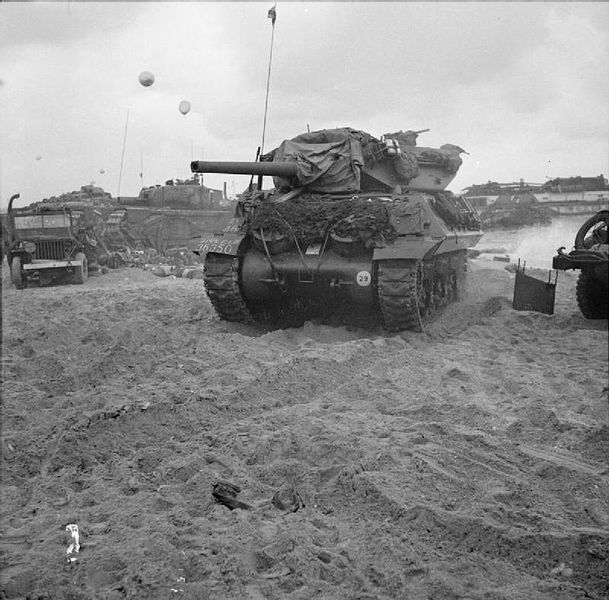The following article on antitank weapons is an excerpt from Barrett Tillman’ D-Day Encyclopedia. It is available for order now from Amazon and Barnes & Noble.
Antitank Weapons: American
Bazooka
Officially the Antitank Rocket Launcher, the ‘‘bazooka’’ was the most famous of American antitank weapons of World War II. Named for its resemblance to musician Bob Burns’s ‘‘gaspipe horn,’’ the weapon was actually produced in several models of varying sizes and weights. The M1 rocket launcher, developed in 1942, was a fifty-four-inch-long hollow tube weighing about thirteen pounds. A 3.2-pound, 2.36-inch diameter rocket was inserted in the breech end and was fired electrically by a dry cell battery mounted on the launcher.
The most common wartime models were the M1 and M9, but all were of a common configuration—a skeletal shoulder stock, a simple pistol grip mounted below the tube, and an optical sight on the left side. The M9A1 was sixty-one inches in length, weighing about 20.3 pounds loaded. The projectile contained eight ounces of pentolite and was considered capable of penetrating three to four inches of armor at approximately one hundred yards. However, not even the M7A1 shaped-charge warhead could penetrate the front glacis of a Panther or Tiger tank.
Approximately 490,000 bazookas were built in World War II.
Antitank Weapons: British
PIAT
British inventiveness accounted for the spring-operated PIAT, which stood for Projector, Infantry, Anti Tank. The 3.5-pound rocket could penetrate as much as four inches of armor, and the weapon was regarded as semiautomatic because it self-cocked on firing. Forty inches long, the PIAT Mark I weighed 34.5 pounds and was sighted for seventy and 100 yards. Because it did not fire a rocket projectile, the rear of the gun had a padded buttstock while the tube was equipped with a fixed bipod and semi-pistol grip. Despite its effectiveness against many armored vehicles, the PIAT proved dangerous to fire and difficult to reload in combat.
Antitank Weapons: German
Faced with overwhelming numbers of Soviet tanks, the German army needed every antitank weapon possible. The same capability became necessary in France, where significant U.S., British, and Canadian armor was committed. Shoulder-mounted weapons roughly comparable to the American bazooka included two major types.
Panzerfaust
Developed in 1943, the Panzerfaust I (‘‘Larger’’) was simplicity itself: a hollow tube 800 mm (thirty-two inches) long firing a 150 mm (six-inch) diameter grenade that projected ten inches beyond the front of the tube. It was fired by depressing a button that released a spring that in turn detonated black-powder propellant. The grenade’s 6.13-pound warhead contained a 3.6-pound bursting charge. Effective range was thirty meters, though sights on some models were calibrated to seventy-five meters. A loaded Panzerfaust weighed about 11.7 pounds—comparable to the unloaded American bazooka.
The Panzerfaust II was known as ‘‘Smaller’’ because its 3.9-inch projectile yielded an ‘‘all up’’ weight of only 7.1 pounds. Its effective range was also about thirty meters, but the 1.6-pound bursting charge could not penetrate armor of the same thickness. By May 1944 production had reached four hundred thousand units.
Thousands of Panzerfauste were captured, and Maj. Gen. James M. Gavin intended to issue one to nearly every trooper in the Eight-second Airborne Division for the planned jump into Templehoff Airport in Berlin. However, the German capitol fell within the Soviet zone, so the operation never proceeded.
Raketenpanzerbuchse
Also called Panzerschreck (‘‘Tank Terror’’) Ofenrohr (‘‘Stovepipe’’), the type 54/1 88 mm rocket launcher was 4.5 feet long and, at twenty-one pounds, nearly twice the M1 bazooka’s weight. The German projectile could defeat as much as eight inches of vertical armor and six inches of forty-degree armor out to 220 yards. However, the powerful rocket engine of the projectile threatened the gunner, who required a bulky blast shield. Deployed in 1944, the Panzerbuchse was largely replaced by the simpler, cheaper Panzerfaust. Normandy’s thick hedgerows afforded Panzerfaust gunners excellent cover for engaging Allied armor at close range.
This article on antitank weapons is from the book D-Day Encyclopedia, © 2014 by Barrett Tillman. Please use this data for any reference citations. To order this book, please visit its online sales page at Amazon or Barnes & Noble.
You can also buy the book by clicking on the buttons to the left.
This article is part of our larger resource on the WW2 weapons development. Click here for our comprehensive article on the WW2 weapons.
Cite This Article
"Antitank Weapons: WW2 Arsenal of America, Britain, and Germany" History on the Net© 2000-2024, Salem Media.
April 21, 2024 <https://www.historyonthenet.com/antitank-weapons-used-by-america-britain-and-germany>
More Citation Information.

